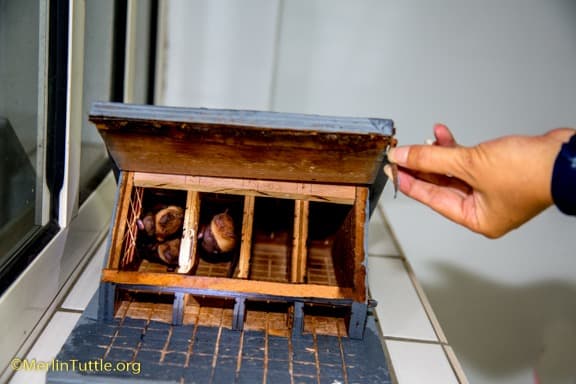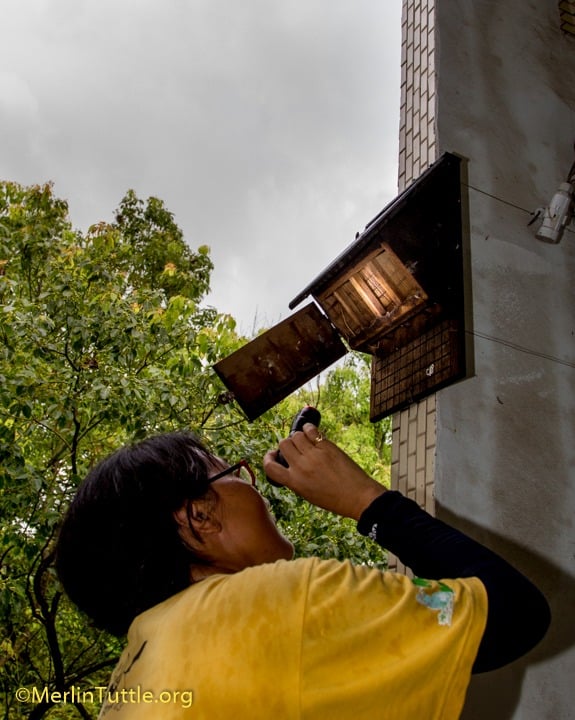Challenging torrential rains countered by cooperative bats in Costa Rica
Merlin and MTBC team members spent 19 days in Costa Rica last November on a filming trip for “Bat City” with its Director and Emmy
Following 30 hours of travel, we spent our first day recuperating in Taipei, got up early the next morning for a 2.5-hour drive to the Formosan Golden Bat’s Home on the campus of the Sheng-Zheng Elementary School, where we met our host, 43-year-old Heng-Chia Chang. As a teacher, he had noticed beautiful little golden bats (Myotis formosus flavus) roosting in school yard tree foliage.
When he learned that these bats were rare and declining, he decided to begin a public education campaign on their behalf, beginning at school. Students became fascinated and helped build 120 small bat houses that were put up at the school. Nearly all the houses were used by bats, but not the golden bats. Two other species, Japanese pipistrelles (Pipistrelles abramus) and chestnut bats (Scotophilus kuhlii) almost immediately moved in and began rearing young in them.


Bat houses are checked daily to study use patterns.
Soon, the entire community became enthusiastic about protecting bats, especially the golden ones, and attracting them is considered good luck. 800 houses built by a local carpenter have been sold through the museum for 37 USD. Visitors are now using them throughout Taiwan.
By 2009 local citizens decided to support a golden bat museum which has become a well known tourist destination. Approximately 20,000 visitors are attracted each year to learn about bats and their values. There is even an annual festival early in April to celebrate the return of golden bats from their winter hibernation sites in the mountains.
The Formosan Golden Bat’s Home funded our visit to highlight and photograph its unique bats in collaboration with the Bat Association of Taiwan. When we arrived, an enthusiastic crowd of 70 had gathered to hear Merlin speak about the importance and needs of bats. He also praised Mr. Chang and the community for their outstanding efforts. Our friend Joe Chun-Chia Huang acted as interpreter for Merlin’s talk. Joe is a native of Taiwan who recently returned from obtaining his PhD at Texas Tech University.
Over the past 10 years, Mr. Chang has observed an 80 percent decline of golden bats at several locations of former abundance. However, those living on the school grounds and in the nearby village appear to be relatively stable, despite the fact that only pipistrelles and chestnut bats are living in the school’s bat houses.
We’ll be documenting golden and other Taiwan bats for the next several days. Photography has been difficult due to almost continuous rain, but it’s finally brightening up!
Love our content? Support us by sharing it!
Merlin and MTBC team members spent 19 days in Costa Rica last November on a filming trip for “Bat City” with its Director and Emmy
“Just like the old days, eh Heather?” Kent softly clicks his tally counter as he sits in his folding chair on the other side of
Bats can use sounds in many complex ways. They can sing and even have different dialects… When imagining a bat, the first thoughts that come
It was a long road to Austin, Texas. More than five years after my first introduction to Merlin Tuttle’s Bat Conservation as a teenager, I packed
2024 © Merlin Tuttle’s Bat Conservation. All rights reserved.
Madelline Mathis has a degree in environmental studies from Rollins College and a passion for wildlife conservation. She is an outstanding nature photographer who has worked extensively with Merlin and other MTBC staff studying and photographing bats in Mozambique, Cuba, Costa Rica, and Texas. Following college graduation, she was employed as an environmental specialist for the Florida Department of Environmental Protection. She subsequently founded the Florida chapter of the International DarkSky Association and currently serves on the board of DarkSky Texas. She also serves on the board of Houston Wilderness and was appointed to the Austin Water Resource Community Planning Task Force.
Michael Lazari Karapetian has over twenty years of investment management experience. He has a degree in business management, is a certified NBA agent, and gained early experience as a money manager for the Bank of America where he established model portfolios for high-net-worth clients. In 2003 he founded Lazari Capital Management, Inc. and Lazari Asset Management, Inc. He is President and CIO of both and manages over a half a billion in assets. In his personal time he champions philanthropic causes. He serves on the board of Moravian College and has a strong affinity for wildlife, both funding and volunteering on behalf of endangered species.